Sheep farming, or animal husbandry, is cultivation for commercial purposes. Sustainable sheep farming has been growing rapidly in India as an agriculture business and source of income for decades. Many countries around the world practice sustainable sheep farming as a traditional occupation. A sheep is raised for its milk, wool, and meat, part of animal husbandry. There are more sheep farms in Rajasthan than in any other state in India.
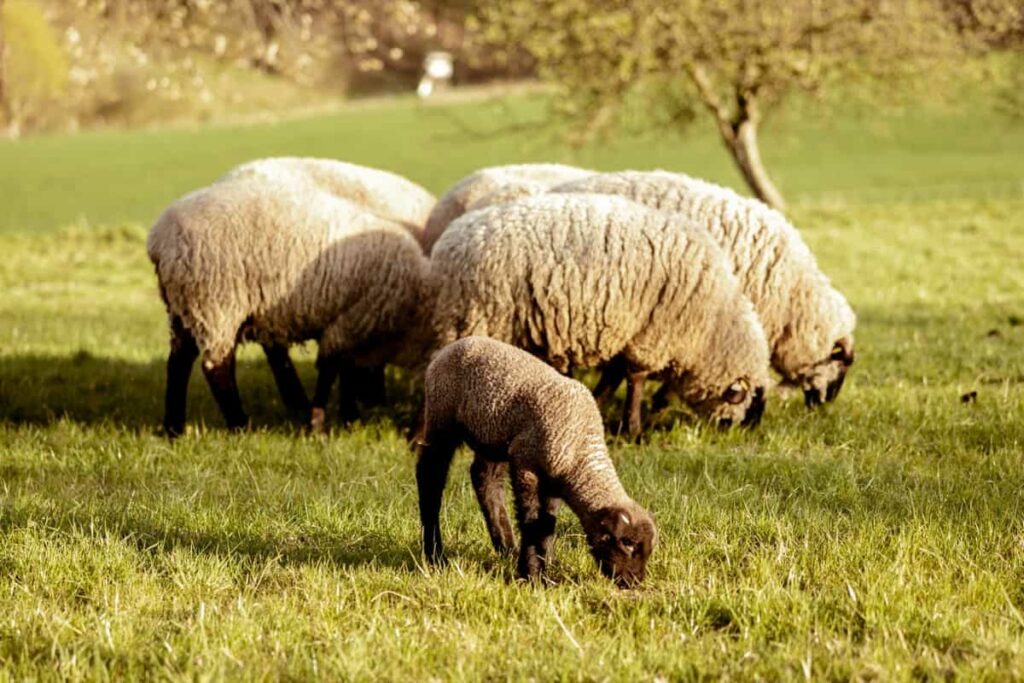
There are many states, including Rajasthan, where sheep can be found in large numbers. Approximately 5 million households in Andhra Pradesh, Himachal Pradesh, Jammu and Kashmir, and Uttarakhand farm small sheep. Sustainable sheep farming can be done on a small or large scale. Finding sheep in arid zones with low rainfall and little agriculture is common.
Most of India’s sheep are found in too dry or mountainous areas for other agricultural purposes. In addition to their wool, milk, skin, and manure, sheep are also popular for their milk. Besides being delicious, its meat is very healthy, nutritious, and popular worldwide. Sustainable sheep farming can raise a good income and help reduce poverty in barren, desert, semiarid, and mountainous regions.
How to Start Sustainable Sheep Farming
Whether you want to raise sheep on a small or large scale in India, the economics will be the same. Small and marginal farmers rely heavily on sustainable sheep farming for their livelihood. Profitability can be challenging, but nobody can stop your profit if you work with productive sheep and have close control of expenses. Here you learn about small-scale sustainable sheep farming and how to establish sustainable sheep farming step by step.
Step 1: Make a Suitable Sustainable sheep farming Business Plan.
The first step in starting a sheep and goat farming business is to develop a budget-appropriate business plan. Your sustainable sheep farming business plan must include financial analysis, marketing strategy, and income revenue.
Step 2: Choose a Suitable Location for Sustainable Sustainable Sheep Farming
Second, you must choose the right location for sustainable sheep farming. A good and freshwater source, enough green food, appropriate medication, and transportation must be available to sheep. India’s sustainable sheep farming business must be handled properly and provided with the necessary facilities.
In case you missed it: Contract Sheep Farming in India: Companies, Agreement, Profits, How it Works and the Pros and Cons
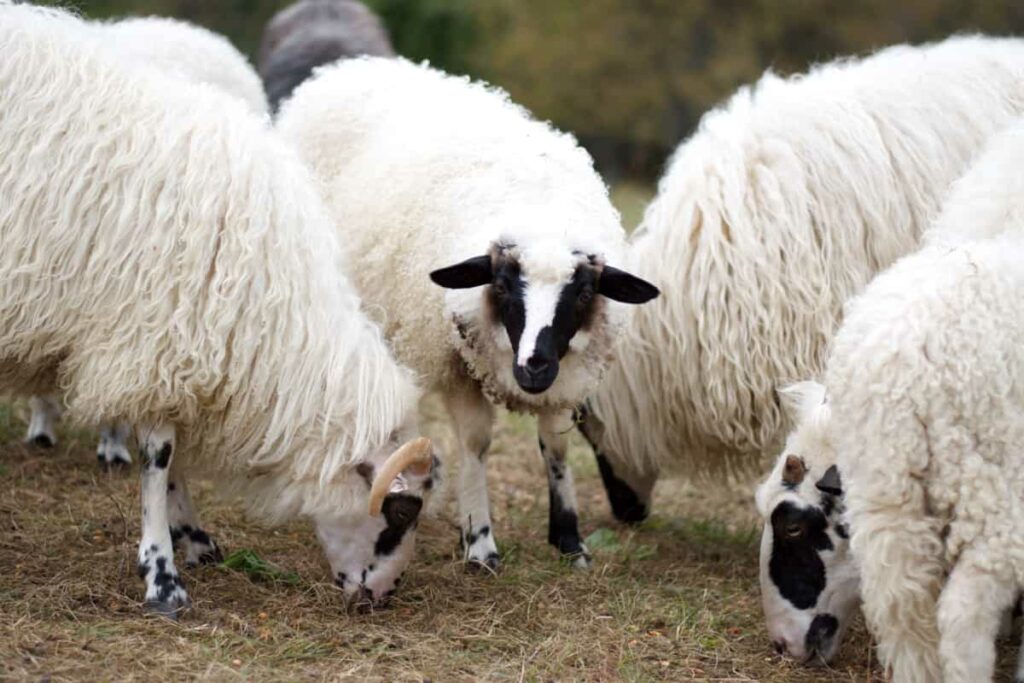
Step 3: Quality of Breeds
A third important aspect of sustainable sheep farming is the quality of breeds, which can increase productivity. There are many sheep breeds worldwide, but not all are suitable for every farming area. Therefore, you must prepare the breeds based on the agricultural climate at your location.
Step 4: Selection of Top Indian or International Sheep Breeds
As a fourth and most important step, choose the breed that best fits your business plan. The followings are the top 5 Indian sheep breeds or international sheep breeds.
| Indian Sheep Breeds | International Sheep Breeds |
| Nali Sheep | Lincoln sheep |
| Cholla Sheep | Dorset sheep |
| Marwari Sheep | Turkana |
| Magra Sheep | Dorper sheep |
| Jaisalmer Sheep | Black-headed Persian |
Step 5: Make a House for the Sheeps
Fifthly, you must provide sheep with a house that can protect them from negative climatic conditions and prevent many diseases. It is necessary to build a separate and suitable house for them. A neat, clean, and dry environment with adequate light and air should be provided. Their house should have a proper drainage system to prevent dirtiness and odors.
Step 6: Healthy Feeding With Good Care
Sixthly, you must feed them properly to ensure their good health. Every living creature, whether animal or human, needs food. Feeding sheep with nutritious food is important to keep them healthy and disease-free. Depending on their age or gender, you should feed them accordingly.
Step 7: Marketing of Modern Sustainable Sheep Farming Business
Finally, you should also determine your marketing strategies and plans before starting a sustainable sheep farming business in India. Market to local markets and areas for better and more effective results. Marketing sustainable sheep farming or sheep products on the international market is better if you have the proper facilities and sustainable sheep farming information.
In case you missed it: How to Make Sheep Manure Compost: A Step-by-Step Guide to Using in Your Garden

A small-scale sustainable sheep farming business can be a perfect source of income for households or individuals. Using a few ideas, you can even make profits from sustainable sheep farming.
- On low capital with higher returns, you can start semi-intensive sustainable sheep farming, where sheep spend half a day in the field and the other half in the sheep shed.
- You can start sustainable sheep farming tutorials for beginners.
- Making sustainable sheep farming videos can be a great way to help others open their sheep farms.
- You can earn money by providing sustainable sheep farming designs and project reports to others willing to do them.
Housing Requirements in Sustainable Sheep Farming
- It is enough to provide sheep with a simple shed made of low-cost housing materials to maximize their productivity.
- In most parts of the country, sheds with mud floors are suitable except in areas experiencing high rainfall.
- A shed should be built in an elevated area to prevent water from stagnating.
- Around the shed, fodder trees can be grown, providing the goats with food as they grow.
- Sheep should have access to clean drinking water.
- Proper ventilation should be provided when building sheds.
- The shed’s walls should be free of cracks or holes during construction.
- The shed’s floors should be firm and able to absorb water. A floor should be constructed so that it is easy to clean.
- There are different types of sheds depending on the type of rearing system.
- Open-type housing with a covered area and run sise are generally sufficient.
- An east-west orientation with ample ventilation and air movement for a comfortable house will be ideal.
- The covered space will be sufficient when the animals are grazed during the day and sheltered at night.
- The shelter can be as long as you like. It is, however, important that the shed’s width does not exceed 12 meters and that the shelter’s optimum width is 8 meters.
- The ewe’s height should be 2.5 meters, and the ridge’s height should be 3.5 meters.
- Feeders and water troughs should be separated for concentrate feeds, green fodders, and water.
- Recommended floor space requirements for sustainable sheep farming
| Age groups | Covered space(sq.m) | Open space (sq.m) |
| Up to 3 months | 0.2-0.25 | 0.4-0.5 |
| 3 months to 6 months | 0.5-0.75 | 1.0-1.5 |
| 6 months to 12 months | 0.75-1.0 | 1.5-2.0 |
| Adult animal | 1.5 | 3 |
| Male, Pregnant, or lactating ewe | 1.5-2.0 | 3.0- 4.0 |
In case you missed it: Common Sheep Diseases, Symptoms, and Treatment: Check How this Guide Helps Sheep Farmers
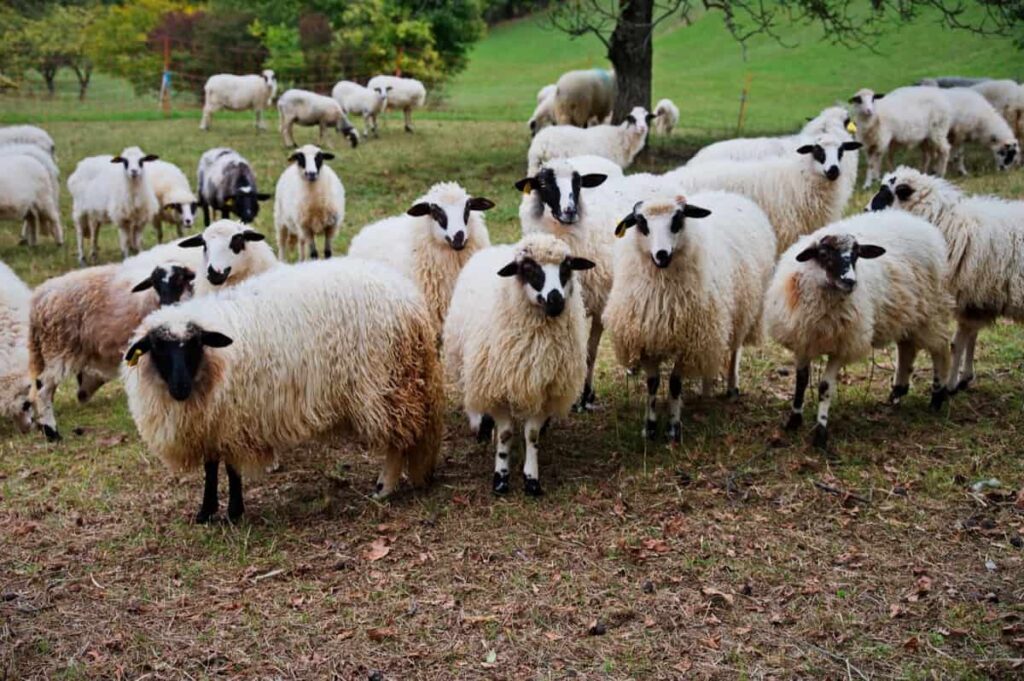
Feeding Requirements in Sustainable Sheep Farming
Feeding Schedule for a Lamb from Birth to 90 Days
| Age of kids/lambs | Ewe’s milk or cow milk (ml) | Creep feed (grams) | Forage, green/day (gm) |
| 1-3 days | Colostrum-300 ml, three feedings | – | – |
| 4-14days | 350 ml, three feedings | – | – |
| 15-30 days | 350 ml, three feedings | A little | A little |
| 31-60 days | 400 ml, two feedings | 100-150 | Free choice |
| 61-90 days | 200 ml, two feedings | 200-250 | Free choice |
Three Months to Twelve Months of Age
- A pasture grazing for about eight hours a day is the norm.
- The supplementation of 100 – 200 grams of concentrate mixture per animal/day should contain 16-18 percent protein.
- When it’s hot during the summer months and when it’s raining, use dry fodder
Adult Animals
- The concentrate mixture must not be supplemented if pasture availability is good.
- If grazing conditions are poor, animals can be supplemented with a concentrated mixture at 150 to 350 grams of concentrate/animal/day, depending on their age, pregnancy, and lactation.
- Concentrate mixtures used in an adult feed contain 12 percent digestible crude protein
Non-pregnant Animals
- Supplementing with concentrate mixtures is unnecessary if pasture availability is good.
- It is recommended that animals be supplemented with 150 – 200 grams of concentrate per animal every day when grazing conditions are poor.
Lactating Animals / for 75 Days After Lambing
- 6-8 hours grazing and 10 kg cultivated green fodder/day
- 6-8 hours grazing and 400 grams of concentrate mixture/day
- 6-8 hours grazing and 800 grams of good quality legume hay/per day
Water Requirements for Sustainable Sheep Farming
The intake of water is crucial for ensuring the health and performance of animals and preventing heat stress. For every 2 kg of dry matter (DM) consumed, sheep will drink about 4 to 6 liters of water. Sheep need access to clean water and ample space to ensure proper water intake. Unclean or poor-quality water can negatively impact consumption, productivity, health, and growth.
In case you missed it: Sustainable Goat Farming: Business Plan, Benefits, and Requirements

The amount of water consumed will vary depending on the temperature and humidity. Furthermore, water requirements change with the production stage since pregnant women, lactating women, and mothers raising multiples have the highest water requirements. To support fetal growth and lactation, ewes raising twins or, more generally, need twice the amount of water
| 60 Kg | 70 Kg | 90 Kg | |
| Maintenance | 2.25 to 3 liters/day | 2.5 to 3.5 liters/day | 3.2 to 4.2 liters/day |
| Pregnancy | 4.5 to 6.0 liters/day | 5.5 to 7.5 liters/day | 6.5 to 8.5 liter/day |
| Lactation | 7.5 liters/day | 9 liters/day | 10.5 liters/day |
Vaccination Schedule in Sustainable Sheep Farming
There are many disease conditions for which sheep and goats may be vaccinated. All flocks and herds should be vaccinated for clostridial diseases, specifically enterotoxemia (type C and D) and tetanus. Other diseases that flock owners may consider vaccinating for are sore mouth, caseous lymphadenitis (CLA), abortions (e.g., vibrio, chlamydia), and rabies, but only if these disease conditions have been diagnosed (by necropsy) in a flock or where the risk is deemed high. Extreme care must be used when administering the sore mouth vaccine, as it is a live vaccine, and sore mouth (orf) is contagious (and painful) to humans.
| Disease | Vaccine |
| Tetanus | Within 48 hrs after birth |
| FMD | Two months of age; repeated once in 6 months. |
| Sheep and goat pox | Six months of age; repeated annual vaccination in an endemic area. |
| Anthrax | Six months of age; repeated annual vaccination in an endemic area. |
| Enterotoxaemia | Six months of age; repeated annual vaccination should be completed before the onset of monsoon. |
| PPR | Six months of age; repeated annual vaccination in an endemic area. |
| Bluetongue | Six months of age; repeated annually. |
Parasite Control in Sheep Farms
Sheep and goats are susceptible to worms due to their close grazing behavior and slow-to-develop immunity. Goats are more susceptible than sheep when forced to graze (versus browse). All sheep and goats have worms. The parasites that cause the most damage to sheep and goats are stomach worms and coccidia. If left unchecked, stomach worms can cause substantial death loss in sheep and goats.
In case you missed it: How to Care for Dairy Goats: Shelter/Housing, Fencing, Feeding, and Disease Control
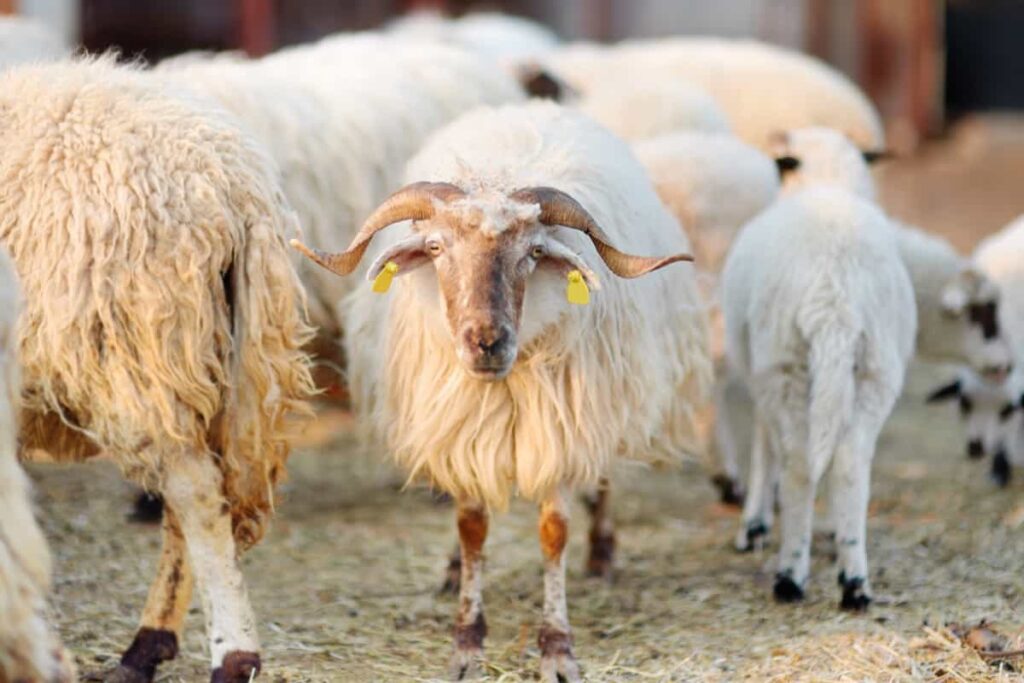
The barber pole worm (Haemonchus contortus) is the stomach worm of primary concern. It is a microscopic, blood-sucking parasite that pierces the lining of the abomasum (the ruminant’s “true” stomach) and causes blood and protein loss and anemia, as evidenced by pale mucous membranes (lower eyelid, gums, etc.) and “bottle jaw,” an accumulation of fluid under the jaw.
Since the primary mode of transmission for stomach worms is grazing, pasture management is an important aspect of controlling internal parasites. Pasture control strategies include using clean or safe pastures, mixed species grazing (with horses, cattle – not goats), and pasture rotation. Pasture rotation will help to control parasites in small ruminants, but only if the pastures are rested sufficiently long – at least 70 days since the last sheep and goats were on the pasture.
Advantages of Sustainable Sustainable sheep farming are:
- Sheep do not need expensive buildings to house them and, on the other hand, require less labor than other livestock. The foundation stock is relatively cheap, and the flock can be multiplied rapidly.
- Sheep are an economical converter of grass into meat and wool.
- Sheep will eat varied kinds of plants compared to other kinds of livestock. This makes them excellent weed destroyers.
- Unlike goats, sheep hardly damage any tree.
- They are well adapted to the environment and poor management practices.
- The production of wool, meat, and manure provide three different sources of income to the shepherd.
- Their lips’ structure helps them clean grains lost at harvest time and thus convert waste feed into profitable products.
- Mutton is one kind of meat towards which there is no prejudice by any community in India. Further development of superior breeds for mutton production will greatly scope India’s developing economy.
In case you missed it: Sustainable Poultry Farming: Benefits and How to Reduce Your Carbon Footprint with Chickens
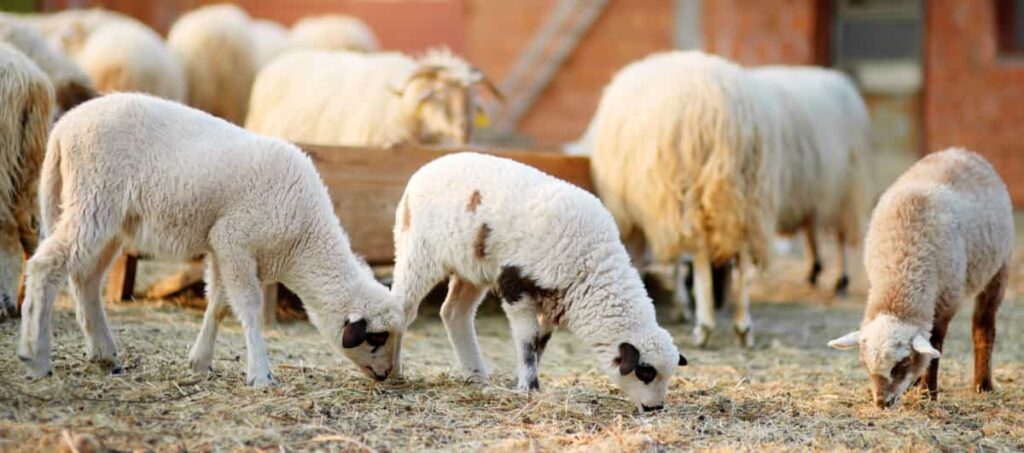
Conclusion
Sheep-husbandry or sustainable sheep farming contributes significantly to numbers and sustainable livelihood options in countries where farmer suicides due to crop failure were more. Sheep are the lifeline in areas where crop failure is commonplace, and the rural population, NGOs, and government are realizing this species’ importance in sustaining their livelihood.
- Broccoli Varieties: Choosing the Right Cultivars for Your Farm
- How to Raise Pigs in Your Own Backyard: A Comprehensive Guide
- Budget Friendly Sheep Shed Ideas: Cheap and Low-Cost Tips
- How Much Do Cattle Farmers Make: Revenue Streams in Cattle Farming
- Management Pests and Diseases in Your Cotton Field
- Sheep Farming Business Plan for Beginners
- Aquaponic Farming at Home: A Step-By-Step Guide
- Profitable Village Farming Business Ideas in 2024
- High-Yield Aquaculture: Fast-Growing Fish for Farming
- Effective Fish Pond Construction Techniques for Beginners
- Irrigation and Water Management in Pineapple Farming
- Blossom to Harvest: Mastering Flowering and Pollination in Papaya Farming
- Pig Fattening Essentials: From Selection to Sale for Beginners
- Raising Wagyu Cattle: A Complete Guide for Premium Beef Production
- Soil Types and Their Water Holding Capacity
- Optimizing Irrigation Schedules for Coconut Groves for Enhanced Yield
- Espresso Your Garden: Coffee Grounds for Healthier Acid-Loving Plants
- The Best Soil Mix for Snake Plants: How to Mix Your Own Snake Plant Soil
- Green Thumb Success: Expert Tips for Cultivating Greenhouse Beans All Year Round
- Bloom All Year Round: The Ultimate Guide to Indoor Hyacinth Care
- Eco-Friendly Gardening: How to Make Liquid Fertilizer from Kitchen Waste
- Ultimate Guide to Grow Anise in Pots: Explore Seed Propagation to Harvesting
- Guide to Raising Chester White Pigs: Discover Breed Facts to Growth Management
- Mastering the Elegance: The Ultimate Guide to Weeping Cherry Tree Care, Planting, and Maintenance
- Ultimate Guide to Planting Garlic in Grow Bags: Growing Strategies for Beginners
- How to Fix Spider Plant Leaf-Related Problems: Natural and Organic Remedies
- 10 Reasons Why Your Tulsi Plant is Shedding Leaves: Home Remedies and Solutions
- Optimizing Growth and Yield: The Advantages of Palm Bunch Ash Fertilizer
- Utilizing Neem Oil Extract as a Natural Pesticide for Hydrangea
- From Soil to Harvest: Various Ways in Which Farmers Can Use AI Tools
- Steps to Encourage and Induce Citrus Flowers: A Comprehensive Guide
- How to Fix Snake Plant Leaf-Related Issues: Natural and Organic Remedies
- Transform Your Garden into a Fragrant Oasis with Raat Ki Rani (Night Blooming Jasmine)
- Discover the Ideal Chicken Breeds for Philippine Farms
- How to Create a Poultry Egg Farm Business Plan for Profits
- Grow Lemon Cucumbers Like a Pro: Insider Techniques for Bountiful Yields
